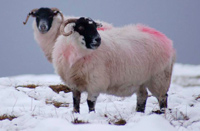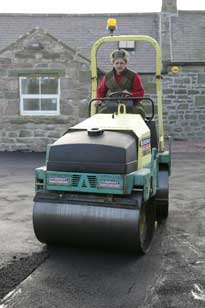Harsh weather hits lambing

Lambing is now a salvage operation, according to Jimmy Sinclair. “Regardless of how well you think you are prepared, you cannot prepare for these weather conditions.”
In fact Crookston farm has been under snow since 17 December with a combined total of five foot of snow falling in this time.
“There are several farmers in this area who will not know the extent of their losses until the snow clears, but I expect there will be many hundreds of sheep and lamb losses across the country,” he says.
And for NSA Scotland chairman, Mr Sinclair, extreme weather has created challenges in lambing his flock of 1100 mules. “We had a power cut for four days, meaning we were reliant on poor light from a generator for night lambing. Roads have also been blocked for days and we have been using contractors to dig out gateways.
“The week before Easter we couldn’t get up to see the hill ewes and consequently we lost about 15 out of a group of 160 and we’ve lost another five today (6 April).”
And there is no doubt, the effects of this extreme weather will be long-lasting. “The consequences of poor weather will be with us all summer through poor growth rates,” he says.
With scanning percentages higher than they’ve ever been, what should be a good season will no doubt take a hit from increased lamb losses.
“Our flock of 700 Blackfaces are yet to start lambing, but I am sure a lot of these hill sheep will be going into lambing with poor body condition.
“The snow and wet has also got into the sheds making pens sodden. As a result we are experiencing higher levels of joint ill than normal.”
Andrew Morgan, Sunnyside Farm, Reston.
For Andrew Morgan, Reston, severe wet weather and blizzards have resulted in 250 lambs dead or missing from his flock of 1100 ewes.
“In one field we found 50 dead lambs. There was just no warning as to the severity of the weather – extreme rain was followed by blizzard conditions, in the space of just two days.
“Thankfully our neighbours were a huge help and offered sheds to shelter some of the ewes and lambs, but we experienced problems with mis-mothering after lambs were bought in.”
To try and help stock still outside, fences were cut to let ewes and lambs into field shelter belts. “By letting them under trees, we saved a lot of lambs.
“I’ve lambed for more than 40 years and last week was the worse two days I’ve ever seen – it was frightening.”
And heavy rain meant more than 100 ewes had to evacuated from buildings. “The drains just couldn’t cope, flooding the whole shed.”
Because lambs were stressed, there has also been an increase in joint ill. “Grass is also non-existent. I have been feeding as much barley and nuts as possible, but we’ve now run out of straw and turnips are just not available.”
Michael Dunn, Gilston Farm, Heriot
The true extent of losses at Gilston Farm are still becoming apparent, but farmer Michael Dunn expects losses to be in the hundreds.
“At the moment, we’ve lost more than 200 lambs, 14 hoggs, six tups and a number of ewes and we’re still discovering more by dykes and in snow drifts.”
As a result, lambing numbers will be significantly down this year. “Scanning results on our 1600 ewes were 170%, but we’ll be lucky if they actually hit 150%.
“I’ve never seen weather like it – on 30 March, right in the thick of lambing, we had 21in of snow, resulting in a power cut lasting nearly three days.”
And with roads closed, reaching some stock was impossible. “We couldn’t reach one shed for 24 hours and had to get a neighbour to feed and water stock.
“With no grass, we are literally pumping feed into them, but now we have run out of hay and until we can get on the fields, we have no cut turnips available.
“Finishing hoggs currently grazing kale and turnips should have been away last week, but the snow made it impossible. Unfortunately we also lost a few.”
Charlie Armstrong – Middle Moor Farm, North Charlton, Northumberland
 |
|---|
| Charlie Armstrong says his farm suffered 90mm of rain in two days. |
For Farmer Focus writer, Charlie Armstrong, severe wet weather has increased lamb mortality rates and forced him to adapt his system to shelter stock.
“We had a ‘killer’ 48 hours at the end of March where we experienced the worst conditions ever seen in this area. In two days we had 90mm of rain. And this was worse than floods seen two years ago, as the rain fell on already sodden ground.”
Currently, 2000 out of 9000 ewes at Middle Moor Farm, North Charlton are lambing. “Just before Easter we had 1000 lambing inside and 1000 lambing at grass. The ones inside were fine, but outside was more of an issue.
“Unless we picked up lambs born outside straight away, we were losing them.”
As a result, Mr Armstrong was forced to use pig huts to accommodate lambs and adapted 800 potato boxes as shelter.
“It is lucky we started growing potatoes a few years ago and had boxes handy. Cattle are already tight in the shed to try and gain a bit of space for the lambs.
And this year, lamb jackets have proved their worth, according to Mr Armstrong. “As soon as lambs were lying down, they were getting wet. We have always used jackets, but this year they have definitely been worth the investment – you only have to save one lamb’s life to make it worth it.”
The flock of 7000 ewes, which are out at grass, are set to start lambing on 17 April. “Feeding these ewes has been a challenge because of the wet ground. We feed out silage first to provide a dry surface and then drive over with the snacker so grain can be put on top.” All in all it is taking three men to get everything fed in the day.
However, over the Easter weekend conditions improved and lambs are now being left outside. “Our biggest challenge now is fluke resistance. Despite treating for fluke four weeks ago, we are having to treat the whole flock again with a new wormer because fluke are resistant.”
Alan Montgomery, Down Patrick, Northern Ireland
Biting winds and heavy rain have meant lambing has been hard for both sheep and shepherd alike, according to Northern Ireland sheep farmer, Alan Montgomery.
“Lamb growth rates are well back and grass growth is not what it should be. Luckily, we batch lamb inside so we do not need to push lambs out. As a result, losses have been minimal among our 800 ewes.”
However, the weather has meant supplementation is a must once ewes and lambs go out. “There is no question over whether to supplement. We hardly ever feed outside, but lack of grass has forced us to do so.
“We are fortunate we are on quick drying, free-draining land, so hopefully, conditions should improve in the next couple of weeks.”
But this season’s conditions are likely to have long-lasting effects on the market, he says. “I think lamb numbers will be down this year because of increased losses and because lambs will finish later, the whole market is likely to be pushed back.”
Iain Green – Corskie, Garmouth, Moray
 |
|---|
| Iain Green has seen extended periods of snow. |
Extended periods of snow and cold weather have meant the 500 Highland Mules at Corskie, Moray, have had to be supplemented earlier than usual.
According to Farmer Focus writer Iain Green, the weather has been horrendous. “At present (1 April), we have 4-5 inches of snow and we have lambed 60 out of our 500 Mules.”
Snow earlier in the season had meant Mr Green had lost one of his buildings and consequently had been forced to put up a poly-tunnel for lambing.
“It was a bit close to call, but we finished building the tunnel the lunchtime of the day the ewes went in.
“We have about 25 ewes and lambs outside, but we are having to hold back a bit because of the weather.”
The farm has always supplemented outside pre-lambing, but this year ewes were fed silage and hay, 4-6 weeks earlier than usual. Concentrate was also supplied three weeks earlier.
“It has definitely been a tough start – the grass has been slow in getting going and we now have a further forecast of frost. It is possible we will have to feed longer than normal.”
And although the farm has enough silage and hay, straw has already had to be purchased for the suckler herd.
“We may also be forced to buy in more concentrates to extend feeding further – it is going to be an extremely expensive winter.”
Oliver Doubleday – Hampstead Farm, Tonge, Kent
According to Kent sheep farmer, Oliver Doubleday, lambing is going well, with little set back from the recent cold weather.
With lambing starting on 10 March, about 85% of the 2000 flock of primarily Suffolk ewes have lambed. “We do have the facilities to hold back ewes and lambs in bad weather when the need arises, but generally we have not felt the need.”
“At the start of lambing, grass was nothing special, but recently applied nitrogen and warm weather two weeks ago has helped grass get going. Ewes are in good order and milking well, and lambs are growing well.
“The recent cold and wet snap may mean we hold back a little this week (31 March), but with most of the flock lambed, this should not cause a problem as there is plenty of room inside.”
The farm always provides supplementary feed to ewes at grass, post lambing and this year has been no different.
Chris Hodgkins – Locks Farm, Washington, West Sussex.
 |
|---|
| Chris Hodgkins won last year’s Farmers Weekly Sheep Farmer of the Year Award. |
For Farmers Weekly Sheep farmer of the year 2009, Chris Hodgkins, developing the genetic base in his flock of 2950, predominantly Romney ewes, has paid off in this year’s extreme cold weather.
“This year has been one of the worst we have experienced. Usually we see a few wet days, but at the end of March we had two weeks of continuously wet nights.”
And with all ewes lambed outside at Locks Farm, Washington, weather conditions are even more of an issue.
“Some fields fertilised three weeks ago were so wet last week it was impossible to get the quad bike across them – grass did start to grow, but fields were waterlogged.”
However, despite the adverse conditions seen a couple of weeks ago, ewes and lambs are coping well, he says.
“On 6 April we had lambed 850, with 400 lambing between 2 and 6 April.
“I am very pleased with how well sheep have coped – we have bred them to deal with harsher conditions and this year we are seeing the benefits. I feel comfortable at night knowing they can deal with it.”
And losses have been minimal. “Because of the bad weather I was not able to get out at night to look out for foxes, but despite this, we only lost one or two.”
Ewes have never been supplemented at grass and this year has been no exception. “Because of fears over mis-mothering I don’t want to go in and disturb ewes and lambs, particularly when they are settled under hedges.”
But with better weather over the Easter weekend, conditions have begun to improve. “Everything is looking more spring like and grass has started to get going,” he says.
2010 Farmers Weekly Sheep Farmer of the Year, sponsored by MorrisonsTimes may be tough, but this makes it even more important to recognise the hard work and dedication undertaken by British farmers. Are you a sheep farmer with a vision for the future and eye for maximising profitability? If so you could be the next Sheep Farmer of the Year. The 2010 Farmers Weekly Awards are a great opportunity to get recognition for everyone involved in a farming business including staff and family. According to last year’s winner’s, Chris and Caroline Hodgkins, Locks Farm, Washington, entering the Awards has proved to be one of the best things they have ever done. “The Awards may have taken us out of our comfort zone, but winning has generated a lot of new interest in our farming system, resulting in increased stock sales. “And in a recent stock sourcing trip to New Zealand, the FW award resulted in us being invited to judge at The Royal New Zealand Show, a live interview on New Zealand radio, and an article in their top magazine.” *The closing date for entries is 30 April, so you still have time to get your entry in. |
|---|
